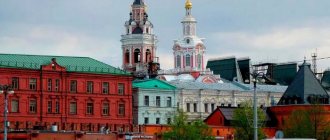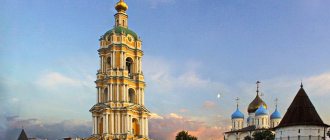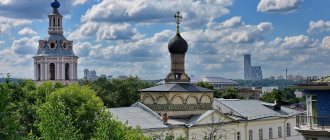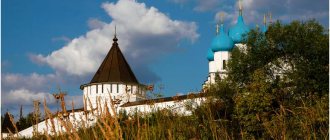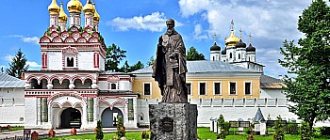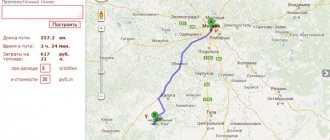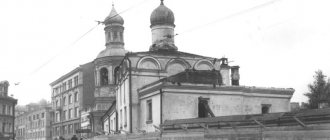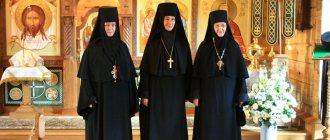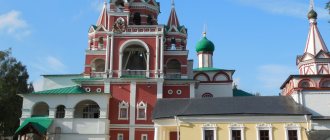Architecture in the Sretensky Monastery
Unfortunately, the church buildings of the monastery, originally created by the architects, did not survive.
Cathedral of the Presentation of the Vladimir Icon of the Mother of God
In the 80s of the 17th century, the main cathedral was rebuilt largely thanks to the financial support of Tsar Fyodor Alekseevich and was consecrated in honor of the Presentation of the Vladimir Icon of the Mother of God. A quarter of a century later, craftsmen added the chapel of the Nativity of John the Baptist to the temple. The cathedral is decorated with ancient Russian frescoes, which can still be admired today. This temple was the only one that survived the crucible of Soviet atheism of the 20th century.
On the lands of the monastery there were two more significant church buildings - the temples of St. Mary of Egypt (XIV century, restored in the 18th century), as well as St. Nicholas. Both are lost.
Cathedral of the Resurrection of Christ and New Martyrs and Confessors of the Russian Church
In 2021 - on the Feast of the Ascension and a century after the revolutionary events that significantly changed the course of the history of our country - in the Sretensky monastery, Patriarch Kirill consecrated a new cathedral - the Resurrection of Christ and the New Martyrs and Confessors of the Russian Church, which was built for three years with the money of believers.
With a height of 61 meters, the bright cathedral seems to float above the city center. For its construction, white stone from the Vladimir lands was used. The temple is richly decorated with carvings, frescoes and mosaics. Almost 50 icons were painted directly for him by masters. On the main fresco “The Last Supper”, which can be seen above the altar, in addition to the apostles, Russian new martyrs are also depicted as saints.
The relics of Hieromartyr Hilarion, abbot of Sretensky Monastery in the 20th century, were transferred to the new cathedral. In the first “Soviet” years he was arrested, the priest died in prison. The ark with his relics stands on stones from Solovki, where Hilarion was a prisoner.
Up to 5 thousand people will be able to attend services in the temple at the same time.
Why this cathedral was built directly in the Sretensky Monastery, you will find out further.
Official website of the Sretensky Monastery
https://www.pravoslavie.ru/
Address
Moscow, Bolshaya Lubyanka, 19
After the communists came to power, the Sretensky Monastery in Moscow for a long time remained a beacon of the Christian faith and, as best it could, fought against the implanted atheism. During the terrible years for Orthodox Christians, the ruler of the monastery was Archbishop Hilarion (Troitsky), a talented theologian and preacher, whose sad fate we reported above.
In the early 20s, the monastery was stripped of its relics, and then it was captured by “renovationists” - there was such a dubious church association. Bishop Antonin (Granovsky) managed the monastery for a year, then, thanks to the efforts of the Hieromartyr Hilarion, they managed to return it under the wing of the Orthodox Church, but not for long - in 1926 the Sretensky Monastery was closed. Almost all of its structures were razed to the ground “to expand street traffic.” Church objects and icons, which the communists did not manage to nationalize, received their new registration in museums and cultural organizations. For example, the icon “The Exaltation of the Cross,” which dates back to the 18th century, is still listed in the collection of the Tretyakov Gallery to this day.
In the 20th century, a hostel was built on the monastery lands for NKVD employees, who shot hundreds of people right in the monastery. To honor the memory of the victims of Soviet tyranny and as a bitter reminder, a worship cross was erected at the monastery in the 90s.
The power of the “workers and peasants” did not spare the cemetery at the monastery, where participants in the war with Napoleon found their rest. In its place a secondary school appeared - studying on the bones of heroes. For a long time, the Sretensky Cathedral housed a scientific and restoration center named after. I.E. Grabar. In the early 90s, the temple became operational again. Later, with private funds, the fence and belfry were re-erected, their style reminiscent of the architecture of the 17th century. In 1996, the Sretensky stauropegic monastery opened a new page in its chronicle.
Over the past years, the Moscow monastery has been revived - restoration was carried out, several buildings were built for monks (there are now about 40 of them), the Sretensky Theological Seminary was opened, the students of which are seriously involved in the affairs of the monastery - they live in the monastery, take part in liturgies, and perform obediences.
The Sretensky Monastery carries out extensive educational work - one of the largest Orthodox publishing houses operates on its lands, and the Pravoslavie.Ru portal is maintained. A center for the study of the Shroud of Turin has been established at the monastery. The choir of the Sretensky Monastery deserves special mention. He is considered the leader of the Orthodox Church and sings at large services, and also performs in concerts around the world.
Monasteries
The monastery is run by two monasteries. One, named after St. Seraphim of Sarov, is located on the site of the Krasnoe estate restored by the brethren in the Ryazan region. The monks' settlement looks like a round fortress, where there is a church, fraternal cells, an apiary, garden beds, a pond, and a barnyard.
There, in the Ryazan region, in Mikhailov, the monastery takes care of a local orphanage, the director of which is a priest - a graduate of Sretensky Seminary.
Another, women's, monastery in the name of the prophet Elijah is located in the Moscow region.
Shrines
The monastery contains: a list of the holy image of the Vladimir Mother of God, the relics of the Hieromartyr Hilarion and other saints, a detailed copy of the Shroud of Turin, an icon of St. Seraphim of Sarov with a particle of his relics.
Sretensky stauropegial monastery Stavropegial monasteries of the Russian Orthodox Church
In the very center of Moscow, in an ancient monastery of the 14th century, the Sretensk Theological Seminary is located - a higher educational institution of the Russian Orthodox Church. Since 1999, the seminary has been educating and training young people preparing for pastoral ministry.
A special feature of the seminary is the direct participation of all students in the life of the Sretensky monastery. For a future pastor, it is important to comprehend the richness and depth of authentic church life, as well as to gain knowledge, experience in scientific work and practical activity. That is why the way of seminary life is structured so that students have the opportunity to both study and participate in monastic services: sing in the choir, perform the obediences of readers or sextons. Students also attend fraternal midnight offices and take part in the reading of the Indestructible Psalter. All this is designed to teach them what will become the basis of their future pastoral ministry: standing in prayer before the Lord for their flock.
Prayerful service is inseparable from other church obediences: spiritual enlightenment and merciful care for those in need. In order for the students of the seminary to be able to feel how great the responsibility of the shepherd is and how significant and important his service is for people, they have the opportunity to participate in interesting educational and cultural projects that are carried out through the work of the inhabitants of the Sretensky Monastery, in significant church-wide events. Meetings with interesting spiritual and secular people, which are held at the seminary, also contribute to the comprehensive preparation of the future priest.
Seminary life
Modern higher theological education has two levels of training: bachelor's and master's degrees. Sretensky Seminary is no exception. Today, about 200 students are studying at the theological school. Most of them are undergraduate students who, in 4 years, are called upon to master a curriculum consisting of many different disciplines of theological, church history, and general humanitarian orientation, so necessary for a pastor in his ministry. Those seminary students who feel the ability and desire for scientific activity move on to the next stage of spiritual education - to the magistracy. Preparation for master's programs has been taking place at the seminary since 2012; its main areas at one time were research in pastoral theology and church history. In 2015, the master's curricula were significantly changed, and the training of masters began to be carried out in three profiles: “Pastoral Theology”, “Christian Doctrine of State and Society” and “Church Slavonic Language: History and Modernity”. The duration of the master's program is 2 years.
Over the years of the existence of the Sretensky Theological School, a seminary choir has been formed within its walls, which sings at services in the monastery, and also participates in international concerts and festivals. The choir is directed by A.V. Amerkhanov, graduate of the Academy of Choral Art named after. V.S. Popova.
Teachers
Sretensky Seminary teaches more than 40 disciplines, including the Holy Scriptures of the New and Old Testaments, theology (dogmatic, comparative, basic, moral and pastoral), liturgics, patrolology, asceticism, history of Russia, history of the Russian Church, general church history and history of Local Orthodox Churches . Also, as part of the educational process, the humanities are taught: ancient Russian, Russian and foreign literature, history of philosophy, rhetoric, psychology, stylistics of the Russian language.
Particular attention is paid to language learning. Church Slavonic, Latin, Ancient Greek, as well as one of the modern languages of the students’ choice are required: English, German, Greek, Arabic, Chinese and others.
The rector of the SDS is Bishop Tikhon (Shevkunov) of Yegoryevsk, vicar of His Holiness the Patriarch of Moscow and All Rus', abbot of the Moscow Sretensky Monastery.
The teaching corporation of Sretensky Seminary consists of scientists of various profiles. Lecture courses are taught by teachers of the Moscow Theological Academy (Professor Archpriest Vladislav Tsypin, Professor A.K. Svetozarsky, Professor A.I. Sidorov), Moscow State University. M.V. Lomonosov (N.N. Trukhina, P.V. Kuzenkov), Literary Institute named after. A.M. Gorky (Professor A.N. Uzhankov), Orthodox St. Tikhon's Humanitarian University (Professor L.I. Marsheva). The seminary's teachers are scientists and specialists from other Moscow universities (candidate of theology priest Mikhail Zheltov, doctor of historical sciences, professor O.Yu. Vasilyeva), as well as representatives of the capital's clergy and inhabitants of the Moscow Sretensky Monastery.
Missionary activities
Seminarians take part in various educational and missionary projects of the Moscow Sretensky Monastery. Every year, over the past few years, seminary students have participated as organizers and guides of the Church-public exhibition-forum “Orthodox Rus'”. This exhibition is one of the most popular and anticipated cultural events in Russia.
The main theme of the exhibition in recent years has been Russian history. The first exhibition dedicated to historical topics was the exhibition “My History. The Romanovs" (2013). An attempt to comprehend the laws of the historical process, to turn from the present through the past to the long past was made at the exhibition dedicated to the beginning and formation of Russian statehood - “My History. Rurikovich" (2014). The exhibition “My History. 1914-1945 From great upheavals to Great Victory." Participation in exhibitions gives seminary students a unique experience of live communication, as well as conducting a discussion in such a frequent clash of different positions and opinions, due to different perceptions of the historical process.
Particular attention is paid at the seminary to preparing students for educational ministry. Thus, seminarians regularly attend a boarding school under the patronage of the Sretensky Monastery in the city of Mikhailov, Ryazan region, the director and confessor of which is a graduate of the Sretensky Seminary, priest Vladimir Shchetinin; conduct missionary classes at the “First Moscow Educational Complex” in Moscow.
Many seminarians work as counselors in the Sretensky children's Orthodox camp “Princely Rus'”.
For many years now, students of Sretensky Seminary have been traveling to the Arkhangelsk and Vologda dioceses during the holidays to restore churches in the Russian North, which gives them the opportunity to directly get to know and fall in love with the life of the Russian province.
During the training process, students acquire skills to work in the largest Orthodox publishing house in our country, the Sretensky Monastery, on the website “Pravoslavie.Ru”, and have the opportunity to participate in the work of the Patriarchal Council for Culture.
During their studies at the seminary, all students at least once go on pilgrimage to the Holy Land, and many members of the student choir go to Bari at the relics of St. Nicholas, Archbishop of Myra in Lycia, the Wonderworker.
Special dates and holidays
A special holiday for the monastery and seminary is the day of remembrance of the Hieromartyr Hilarion (Troitsky) - the heavenly patron of the Sretensky Monastery, which is celebrated on December 28 AD. Art. This day marks the end of the first semester. During the all-night vigil on the eve of the holiday, 1st year students receive a blessing to wear cassocks.
The patronal feast of the monastery is the Presentation of the Vladimir Icon of the Mother of God (September 8, New Art.).
Another day of celebration of the Vladimir Icon of the Mother of God is also solemnly celebrated by the pupils of the theological school - June 3. Art. – for seminary graduates, this is not just the end of the academic year, but the day of the solemn presentation of diplomas.
